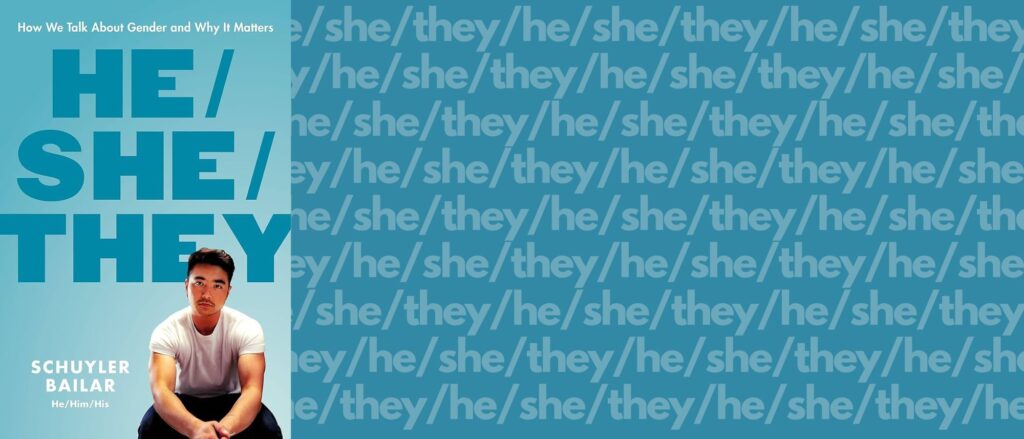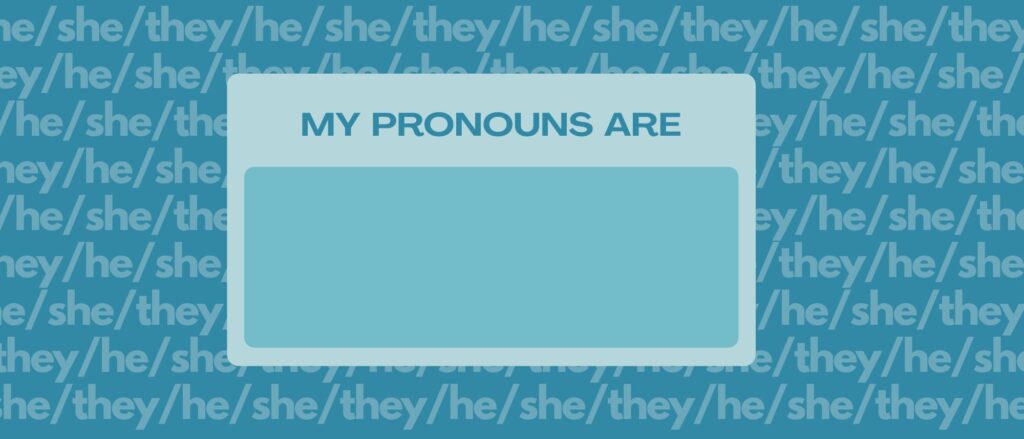A Review of Schuyler Bailar’s He/She/They
I grew up in the 90s, when parents didn’t talk about gender or sexuality. Kids like me were a large-scale experiment: if our parents didn’t tell us about LGBTQ+ people, we’d turn out normative.
It didn’t work. Some of us say, “I didn’t have the words,” to explain a strange, surreal, dissociated childhood. But it’s not just that we didn’t have the words. We didn’t understand the ideas. We couldn’t express who we are.
I didn’t fit in as a kid. My clothes were never quite right. I was always saying the wrong thing, or not saying enough. One afternoon, I stood next to a classmate on the side of the lawn outside the community center. She was very tall, and I was very short, and we both had long brown hair. We were watching the boys play freeze tag. In our social group, girls didn’t run around.
She turned to me and said, “I wish I was a boy.” I wondered if she meant that, or if she just wanted to play tag.
“Yeah, me too,” I responded. I didn’t care about playing the game.
I didn’t know how to talk about gender when I was growing up, but I was lucky enough to learn as an adult from trans authors. Schuyler Bailar is the bestselling author of He/She/They: How We Talk About Gender and Why It Matters, a public speaker advocating for trans inclusion, and the first openly trans athlete to compete on an NCAA Division 1 men’s team in any sport. In He/She/They, Bailar describes a conversation with a worried mother after one of his speaking events. Her eleven-year-old child was in the hospital following extreme distress. “She—he! He was in the hospital,” this mother said. “He says he wants puberty blockers. But I don’t know if they’re safe!” Puberty blockers are medication to delay the onset of puberty, commonly used in children who experience puberty too early. Bailar was reassuring with a hug and kind words. But the mother continued with her deeper concern, “I’m just so worried he’ll regret it, what if he’s wrong?”
Bailar answered, “Oh, but what if he is right,” continuing, “What if he is right about who he is?”
What if we’re right is the heart of Bailar’s book. What if respectful language and gender-affirming health care can reduce suicidality and help trans people grow into happy, thriving, fulfilled adults?
No one ever told me I could be right about myself and my gender. I was subconsciously taught to ignore my truth. People told me I was “one of the guys” or that I “had a masculine way of thinking.” But I was convinced I must be a girl. I became misogynistic. Wouldn’t everyone prefer being a boy instead of a girl? And if I could do anything a boy could do, wasn’t that good enough? But I wasn’t truly okay with being a girl. And I did a bad job pretending to be one.
In He/She/They, Bailar shares that some people thought he was a boy when he was growing up and he feared not adequately performing as a girl. Before swim practice, Bailer would take off his shirt to reveal his women’s bathing suit before even entering the women’s locker room. He had to make sure others were comfortable seeing him as a girl. Reading this, I felt reassured knowing that I wasn’t the only one who struggled to fit in, hoping for acceptance even though I was a trans child.
I felt many strong emotions while reading He/She/They. I cried at the wonderful story of a man coming into his own identity then deciding to help others. I felt angry and resentful because I didn’t have a resource like this when I was younger, and because trans people experience so much unfounded hate in today’s society. I felt supported, as Bailar answered tough questions with respect and confidence.
Bailar builds empathy for how complicated the trans experience can be in our highly gendered society. I didn’t have a map to explore my identity. I grew through a slow, difficult process from “something is wrong with me and I don’t know what that is” at age 15 to “something is wrong with my gender” at age 25 to “I am a non-binary, transmasculine person” at age 33. “Non-binary” means that I am neither fully a man nor a woman. “Transmasculine” indicates the direction I am transitioning toward, becoming more masculine in my gender expression. I chose a new name (Rey) and pronouns (they/them).
When I discovered and accepted these words to describe myself, “something is wrong with me” left my vocabulary. I gained a new ability to accept myself as I am.
I am grateful for the help I received from friends and books to find the right words for my identity. As Bailar writes, “…most people are good people. Some just need a little help finding the right words, trans or not.” He reflects on what a big difference the right words can make: “When I finally found the word transgender, I wished I’d had it in my early years. This was the word I’d been searching for. This was the permission I’d never been given as a little kid to say, ‘I’m actually a boy!’”

Books have always helped me figure out where I fit in. They’ve let me find my sanctuary, my education, and a world where I’m not judged. Growing up, the closest thing I had to trans representation in a book was Tamora Pierce’s Song of the Lioness series. In her novels, the character Alanna lives as a boy for years while training to be a knight. Pierce makes it clear that Alanna remains a girl, reminding the reader as often as three times in a page. Regardless, I clung to the idea of a girl who everyone thought was a boy.
In my late twenties, I started frequenting the LGBTQ+ section of my local library. I was too shy to check out any of the books. I pulled a round stool over to the shelf, sat down, and read about trans people for the first time. I read that some people changed their gender expression to match how they felt internally. I was hyperfocused and fascinated but did not see myself in these texts–not yet.
Weeks later, I worked up the courage to check out a trans memoir, which I sandwiched between two fantasy novels. “Just because I’m checking out this book doesn’t mean I’m trans,” I thought defensively, breathing shallowly as the librarian scanned my books without comment. The next week, I checked out another book talking about trans experiences, and another. I read every book I could on being trans, but I still didn’t think I was trans. I couldn’t explain my fascination with gender.
Those authors didn’t make me trans or non-binary—I always have been—but they let me know other people like me exist and live good lives and write about who they are. My coming out as trans and non-binary is forever intertwined with writing. I wrote down my feelings and figured out what I needed to say. Reading and writing these truths meant I could experience my life.
After coming out, Bailar immediately shared his experiences of being trans with the public, advocating for himself and others during a media frenzy about his being a trans swimmer on Harvard’s swim team. Bailar recalls one particularly cutting remark a commenter wrote on a national profile: “From beautiful competitive woman to mediocre ugly man.” While Bailar presents this comment without casting judgment, I felt defensive on his behalf. It didn’t seem fair. The media created this divisive uproar about this kid who devoted years of his life to swimming and also happened to be trans. Bailar recalls the experience of his first swim meet on the mens’ team: “A year ago, I was ready to quit the world and life altogether. But today, I am standing tall, a proud Korean American queer transgender swimmer on Harvard Men’s Swim and Dive…”
Bailar doesn’t shy away from addressing difficult comments. He knows what it’s like to come out as trans, from his own experience and from talking with many other trans people. His chapter titled “‘You Lied to Me’—Trans People and Disclosure” hits close to home. I’ve had someone I considered a friend say, “You lied to me,” after he found out I was sharing my non-binary, trans identity online. I tried to explain that I hadn’t lied, but rather I didn’t want to talk about my identity with people who I thought would not be interested. I was willing to continue the conversation, but he did not. Reading stories like Bailar’s can be incredibly educational for anyone who isn’t trans to help understand what it’s like to navigate life as a trans person.
He/She/They addresses hateful comments and rhetoric attacking trans people found everywhere on the internet, in the news, and around the family dinner table. Many of these hurtful examples felt familiar to me from social media. Responding to comments ranging from “You’re ruining your body” to misogynistic jokes, Bailar somehow has the grace to assume that some people making these comments have good intentions and may be open to learning about the trans experience.
Bailar recounts talking to a middle school student who was very upset by the suggestion to introduce himself with his pronouns. Curious, Bailar asked why pronouns and gender mattered so much to the student. The student responded, “My parents and I are Christians…I talk about this a lot with my parents! And the Bible says ‘no’ to trans people!”
Bailar describes what he realized from this interaction: “At the core of [the student’s] rejection of pronoun usage was his fear that accepting me and trans people and our pronouns would fuel a disconnection with his parents—a very real and terrifying concept. I empathized with him…rejection of transness is rarely about transness itself but rather something it stirs or threatens in others.”

I was scared that my gender identity could separate me from my partner, friends, and family. I tried to warn my partner something was wrong with my gender. Those are the words I used. “There’s something wrong with my gender.” He was not warned off. I asked him not to refer to me as a woman. He asked me why. I couldn’t explain, yet.
One of the first openly non-binary people I met loved to wear dresses and perfectly applied winged eyeliner to go out dancing. I recognized my friend’s trans identity, and it was so helpful to see someone who dressed like me but was not a woman. With a relatable role model, I started to understand I was like that too. I had buried these feelings for decades. Meeting a person like me didn’t make me trans; they helped me express my innate truth.
As I explored the masculine side of my gender identity, I was wearing women’s clothes, sometimes in a masculine or butch way and sometimes extremely feminine. I dressed up for a Halloween party, wearing a push-up bra, red dress, and a lot of makeup. My friend asked how I felt about dressing like that.
“It feels like wearing drag to me,” I said. My over-the-top femme costume didn’t represent my true self, but it was supposed to be temporary make-believe. The problem was that I had been wearing this costume for my whole life, not only in the clothes I wore, but by how I acted and how I talked about myself. Being a woman didn’t fit me.
My friends and books like He/She/They: How We Talk About Gender and Why It Matters let me know it was okay to say, “I am a boy,” or, “I am non-binary” instead of “I wish I was a boy.” Eventually, when I was ready, I used those words to share who I have always been. I’ve been asked, “Can’t you just be a woman? Why do you have to call yourself non-binary?”
It is not better to be a woman than to be non-binary. It is not worse. My gender simply is what it is. When I finally accepted who I was and wasn’t, I gained space to feel positive and supportive toward women without my own baggage getting in the way. I had allowed my own resentment of being forced into the role of a woman to make me uncomfortable with the idea of anyone being a woman. That was wrong. I now understand that many women love and appreciate their gender identity, and I respect that and am an advocate for women’s rights and women’s spaces.
Today, at 33, I have written extensively about being trans and non-binary. I’m proud of who I am. Figuring out how to express this deep truth about myself without shame and without feeling like something is wrong with me has been the single most important thing I’ve done to improve my mental health, build my self-confidence, feel good about promoting my work, and strengthen my relationship with my partner and friends.
It can be hard to talk about being trans. It can be especially hard to talk about other people being trans, particularly if you are not sure how to be respectful. A great memoir and guidebook, He/She/They can help you, whether you’re trans or not, treat trans people with respect and break through those decades of silence when we didn’t have the words.
—
Rey Katz is queer and nonbinary and writes about LGBTQ+ rights, respectful conversations, and martial arts as a second degree black belt in Kokikai Aikido. Their work is published in POPSUGAR, Catapult, BREVITY’s Nonfiction Blog, Massive Science, and other publications. Check out Rey’s weekly essays at reykatz.substack.com and videos on TikTok, YouTube, and Instagram.



